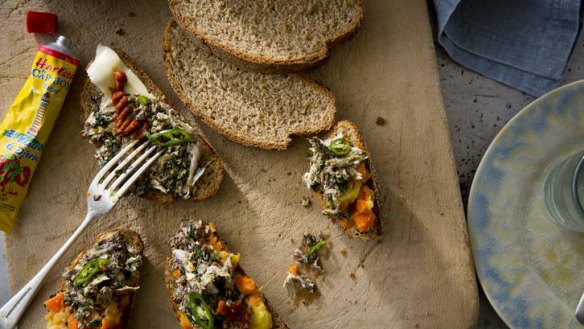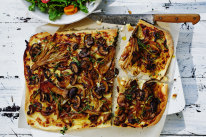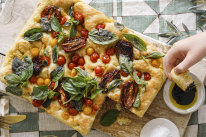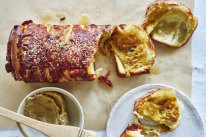Wholemeal and rye no-knead sourdough loaf

The principle of a sourdough starter is pretty simple: a mixture of flour and water is left to allow ambient yeast and acidic bacteria to generate a stable ferment that kills off any nasty microbes and provides a natural leavening agent for baking. The time it takes for the starter to kick off will vary, as will the strength of the ferment, but once it's been fed a few times it should be pretty robust.
Ingredients
Makes one loaf, but the starter will keep indefinitely if fed.
For sourdough starter (prepare days in advance)
300g organic wholemeal flour, plus extra to feed
500ml spring or filtered water
For wholemeal and rye no-knead loaf
250g organic plain flour
120g organic wholemeal flour
120g organic rye flour
250g starter batter
12g salt flakes
semolina, to dust
Method
For starter:
1. In a large, broad-mouthed jar (more than twice the size of the starting batter) combine the flour and water until there are no lumps and the sides of the jar are as clean as possible. Cover the jar with cheesecloth and set aside somewhere warm for two to three days.
2. After two or three days the mixture should have picked up a sour, beery smell and started to gently bubble - but how active the starter is will depend on the environment and the flour, so be patient if it is a little slow to get going. Add 100 grams more flour and enough water to keep a thick, paint-like consistency. Mix until there are no lumps, making sure to work all the starter up from the bottom of the jar and to clean down the sides. If the starter increases significantly in volume, it will be ready to use, though sometimes you will need to feed it a couple more times (you can just remove and discard some of the starter, or use some of the starter to accommodate the next feed).
3. Once active, cover (don't seal airtight as it needs oxygen and will produce carbon dioxide) and refrigerate. Feed every three days with 100 grams of flour and water.
For bread:
1. Mix the flours together in a large bowl. Mix together 225 millilitres water, the starter and salt and add to the flour. Combine well, shape into a round, place in a large bowl and cover with clingwrap. Set on the counter to prove and double in size - this will take between 12 and 20 hours.
2. Once the dough has risen, turn it out on to a clean tea towel scattered with semolina. Gently reshape into a round loaf and allow to rise again in a warm place for an hour.
3. Preheat oven to 250C conventional and place a cast-iron pot inside with the lid on. Heat for 20 minutes then remove the pot, scatter in some semolina, drop the dough inside and bake with the lid on for 30 minutes. Check to see that the crust has developed - if not, cook for a further 5-10 minutes with the lid on.
4. Remove the lid and bake for a further 20 minutes, then tip out of the pot on to a wire rack and rest until cool. The loaf should sound hollow when tapped.
Serve with Karen Martini's smashed sardines
Appears in these collections
The best recipes from Australia's leading chefs straight to your inbox.
Sign upFrom our partners
Similar Recipes

Easy, fun, Friday night food: Lamb skewers with cheat’s crispy egg pancakes
- < 30 mins
- Jessica Brook



